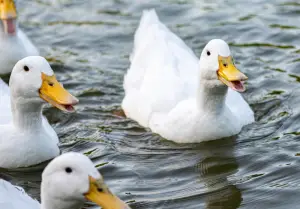How Fast Ducks Grow
If you’re considering raising ducks on your farm, it’s best to raise them from birth. This will help the ducks adjust to their environment and human contact, ensuring they will be more affectionate towards you and comfortable in their home.
But, you might be wondering, how fast do ducks grow? Ducks grow surprisingly fast. In fact, they tend to look like fully-grown adults by around 10 weeks old and reach sexual maturity by around 20 weeks old. Ducks progress each week, growing and developing further into the stages of adulthood.
It’s important to note that duck growth cycles vary depending on their breed. The most popular breed of duck for domestic settings, and in the US, is the Pekin duck. These are the white, fluffy ducks that appear in Aflac commercials. They are a popular choice for pets due to their friendly demeanor, flightlessness, and high rates of egg production.
In this article, I’ll be going over the entirety of a duck’s growth cycle, from incubation to full sexual maturity. Because these cycles can vary greatly between species, I will be solely focusing on the Pekin duck. Generally, you can apply these milestones to other duck breeds as well, but they may not line up perfectly with the Pekin lifecycle.
Pekin ducks are popular in the US for meat and egg production due to their speedy growth cycle, so most ducks do not develop as quickly as they do. It’s important to keep that in mind when deciding on a breed of duck to purchase!
Duck Growth Timeline
Incubation Period 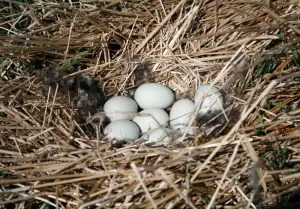
Most people looking to start their flock of ducks for the first time will not be purchasing duck eggs. Fertilized duck eggs are more commonly found within existing flocks after the male and female ducks have become familiar with one another. However, it’s important to understand duck incubation and the best ways to support your hens during this period.
Pekins ducks typically incubate their eggs for about 28 days. During incubation, it’s important to rotate the eggs a minimum of four times a day. This can easily be accomplished by purchasing an incubator or by hand-turning the eggs.
If you’re hatching eggs that have come from one of your own flock, the mother duck will go broody and settle on the eggs herself to keep them warm during the incubation period. If you can, avoid cleaning the eggs as it may disrupt the protective coating on the outside of the shell.
Hatching 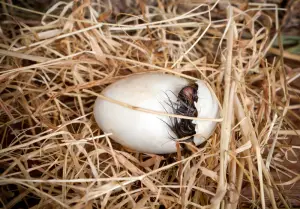
Eggs will typically begin to show signs of hatching about 48 hours beforehand. The first signs of hatching are a large crack in the protective layer of the shell and movement within the eggs.
Ducklings that have developed normally are well-equipped to break through their shell due to something called an “egg tooth”. This is an appendage attached to the tip of their bill that helps them breach through their shell when it’s time to hatch. It usually falls off naturally after the ducklings fully escape the confines of the egg.
The actual hatching can take anywhere from 3-24 hours. Unlike in the movies, it’s not instantaneous and actually takes a lot of effort from the duckling to break through the shell.
Directly after hatching, ducklings will imprint on the first person they see. Imprinting in the wild usually happens between a mother duck and her babies, as a way for the babies to identify and bond with their mother. However, ducks can also imprint on humans, so if you’re looking for a lifelong attachment, make sure to show up for your ducks when they hatch!
Contrary to popular belief, ducklings are wet and exhausted upon emerging from their shell. It might be tempting to dry them off or hold them as soon as they hatch, but you should resist the urge. It’s best to give the ducklings 12-24 hours to fully recover from hatching before you disturb them.
2 Week Old Ducks 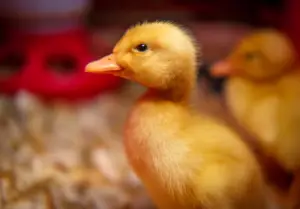
The first 2 weeks of a duckling’s life are when they are most vulnerable. They have not yet developed hearty feathers, so they are susceptible to hypothermia and waterlogging if they are left unattended near bodies of water for extended periods of time.
Ducklings do eat a lot of food and drink a large amount of water, about three times as much as chicks, so it’s important to make sure they have unrestricted access to both at any given time. All you have to do is ensure that the ducklings’ drinking water is clearly separated from any bathing and playing water.
In the wild, this is the period during which ducklings are the most vulnerable to predators. To protect your domesticated ducklings, provide them with an enclosed, outdoor space to play as well as a shelter with a predator lock on the door at night. This will keep your ducklings safe from foxes, coyotes, and skunks.
Due to their lack of thick feathers, ducklings will also have trouble regulating their body temperature at this stage. Monitor your flock to see if they are huddled around a particular heat source, or if they’re panting and trying to spread out to cooler areas. This will tell you whether or not you need to provide an extra heat source, like a hot water bottle.
3-5 Week Old Ducks
By the time the ducklings are 3 weeks old, they should be more weather-dependent and allowed to play outside. They are still vulnerable to predators at this time, so make sure that they are supervised and protected while playing outside.
Upon hatching, Pekin ducklings will be completely yellow in color. At around the 5-week mark, these ducks will begin to lose their yellow color and start to turn fully white. This is your indicator that your little babies are growing up!
At this point, their feathers have not fully started to develop and they still have their downy, babyfur to cover them. This is best described as the “puberty” period for ducklings. They are beginning to exhibit signs of physical maturity, but they’re in no way fully grown yet.
7-8 Week Old Ducks
At this point, your ducklings will be fully white instead of yellow. They will resemble adult Pekin ducks quite closely, but they will still be lacking their adult feathers. The ducklings will also not be fully developed physically, still a little smaller in size than they would be if fully grown.
If you’re raising ducklings for meat, this is the best time to butcher them. This is because there are no newly-grown feathers, which means there won’t be any pin feathers on your finished product. However, if you want a fully grown, larger duck to butcher, it’s fine to wait a few more weeks before butchering them.
It’s also important to reiterate that Pekin ducks are flightless birds, so while other breeds of duck may be maturing into their wings at this point, the Pekin will remain grounded. For example, Mallard ducks can typically fly by the time they’re around 50 days old.
10-Week Old Ducks 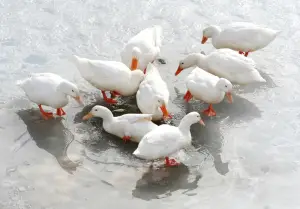
At 10 weeks old, most Pekin ducks are fully grown. They resemble an adult bird and they have all their adult feathers. They are ready to be left outside for long periods at a time, and you don’t have to worry about them getting hurt or drowning while they splash around in the water.
These ducks will be physically wider than ducks of 7-8 weeks of age due to the development of their feathers. Though they won’t necessarily be any heavier in weight than these ducks, the adult ducks will certainly be wider in shape at this point.
The only milestone these birds have left to hit is sexual maturity, upon which they will begin to produce eggs.
17-24 Week Old Ducks 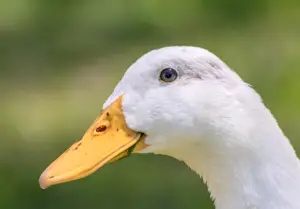
This is the point at which Pekin ducks will begin to lay their eggs! A Pekin hen lays between 200 and 300 eggs during one season, which is considerably more than chickens lay. Each egg weighs roughly three ounces, and they can be used in almost any recipe that requires eggs. They are especially good for baking!
Pekin hens do not need a nesting area, like chickens. Instead, they prefer to drop their eggs periodically from dusk until dawn. They will lay a majority of their eggs during this time, making it easy to retrieve the eggs before they get crushed or dropped by the flock in the daytime.
At this point, obviously, Pekin ducks are also readily available to breed. If you want to prevent your flock from reproducing, all you have to do is separate the males and the females from one another. It can be difficult to sex ducklings, but there are plenty of handy guides on the internet that will teach you how.
If you are interested in producing cute little ducklings, all you have to do is wait. Ducks typically mate in the water, so if you’re trying to encourage mating, make sure that they have open access to clean bathing water at all times. Other than that, just be patient and let nature run its course.
You can check out more of my recent articles about ducks below!

